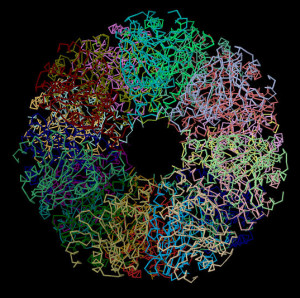In the last decade, Velcade has been tested against a long list of other cancers, including melanomas, lymphomas, as well as prostate, lung and breast cancers. The results have been mixed, particularly for breast cancer.
But in the case of breast cancer, the uncertain outcomes may in part be because past trials looked in the wrong place. New research by Fabio Petrocca, MD, and Judy Lieberman, MD, PhD, in Boston Children’s Hospital’s Program in Cellular and Molecular Medicine, suggests that proteasome blockers like Velcade may indeed have a place in the breast oncologist’s armamentarium, but just for a particular aggressive kind of breast cancer called basal-like, triple-negative breast cancer (TNBC).
TNBCs don’t express the three major therapeutic breast cancer markers—the estrogen, progesterone and HER2 receptors—and, as such, don’t respond to hormone therapy or the HER2-targeting drug Herceptin®. Primarily diagnosed in younger women, they have the worst prognosis of all breast tumors.
To probe TNBCs for undiscovered weaknesses, Lieberman and Petrocca led a team that systematically probed two genetically identical but behaviorally different breast cancer cell lines: an aggressive, TNBC-like one called BPLER and a tamer one called HMLER.
Using RNA interference (RNAi)—a process that uses small pieces of RNA to silence the expression of individual genes—the team studied the two lines at a functional level, turning more than 17,000 genes off, one by one, in both cell types. Their theory: Any genes that BPLER cells need in order to survive but which HMLER cells could live without might be important drug targets for TNBCs.
As they reported in August in Cancer Cell, the RNAi screen returned a bonanza of potential targets: 154 genes to which BPLER cells were “addicted,” but HMLER cells were not. When they compared that signature against other human tumors, it was strongly associated with TNBCs with poor clinical outcome.
A recycling fix
From that gene set, 15 genes involved in proteasome function jumped out. The proteasome is a tubular “machine” within cells that helps break proteins into amino acids; the cell can then reuse the amino acids to make new proteins. (You can see how it works in this animation by the Howard Hughes Medical Institute.)Velcade, which inhibits the proteasome, kills multiple myeloma cells because they are proteasome “addicts”—they need active proteasomes in order to survive. Early studies of Velcade showed that healthy cells, on the other hand, can compensate for blocked proteasomes by other means.
Could BPLER cells—and, by extension, TNBCs—also be proteasome addicts? To find out, the team treated several different kinds of breast cancer cell lines with Velcade for 24 hours. The result: Velcade killed the BPLER and other related TNBC-like cells very effectively, much more so than cells from other breast tumor types.
Velcade was particularly effective against tumor-initiating cells (T-ICs) in the BPLER line and many other established TNBC-like cell lines. If not killed or removed during therapy, T-ICs can cause tumors to recur or seed metastases.
“Targeting T-ICs is the holy grail of cancer treatment,” says Lieberman, who is also a professor of pediatrics at Harvard Medical School.. “They’re resistant to most chemotherapy drugs. Finding something that could be their Achilles’ heel is very exciting.”
Addressing the 15 percent
So why did Velcade fare poorly in past breast cancer trials? Petrocca thinks he knows.
“Velcade doesn’t penetrate solid tumors well,” he explains. “And the patients in those trials weren’t stratified by tumor type. TNBCs represent only a small percentage of breast tumors, about 15 percent, so there would have been few TNBC patients in those trials.
“If we were to try a second-generation proteasome inhibitor in an adjuvant fashion and treat only basal-like TNBC patients,” he continues, “we might see better results.”
What of the other 139 genes the team caught in their screen?
“There are lots of other things to investigate, such as genes involved in molecular transport or glycolysis,” Petrocca says. “Some companies are already developing drugs against some of these genes.”
Lieberman sees this kind of large-scale functional approach as a crucial tool for understanding the breadth of changes in cancer cells and what those changes mean.
“The truth is that genome-wide RNAi is becoming a more common strategy for finding new drugs and conducting new science,” Lieberman adds. “Cancer is so complicated that if you look down just one pathway, you’ll miss a lot of what’s going on.”









